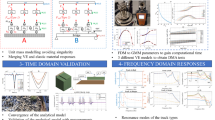Abstract
Ropes made of twisted polyester (PET) yarns have been replacing traditional steel ropes and chains as mooring lines for offshore platforms in deep-sea environments. In order to optimise rope manufacture and the design of mooring systems, a thorough understanding of the material’s mechanical behaviour is necessary. Besides PET, other materials can also be considered such as PEN, as it also a polyester similar to PET but stiffer. This paper presents a study and comparison of PET and PEN fibres’ mechanical behaviour, based on experiments carried out on single filaments. Both fibres show similar non-linear tensile behaviour, with an evolution of modulus in four steps. The same microstructural model is proposed for both fibres, based on microfibrils aligned along the fibre axis and composed of an alternation of amorphous, mesamorphous and crystalline phases. The shape of the tensile loading curve is explained by the successive loading of these phases. Creep behaviour is also evaluated by considering the evolution of creep rate with applied load. This evolution is again similar for PET and PEN, both from a qualitative and quantitative point of view. The similarity in creep rate values for both fibres indicates that the microstructural mechanisms involved in creep may differ from those involved in short term tension loading.









Similar content being viewed by others
References
Flory JF, Banfield SJ, Berryman C (2007) In: Offshore technology conference proceedings OTC 18768
Fernandes AC, Del Vecchio CJM, Castro GAV (1998) In: 8th international offshore and polar engineering conference proceedings, Montréal, Canada
De Pellegrin I (1999) In: Offshore technology conference proceedings OTC 10907
Van Den Heuvel CJM, Klop EA (2000) Polymer 41:4249
Wu G, Li Q, Cuculo JA (2000) Polymer 41:8139
Bedia EL, Murakami S, Kitade T, Kohjiy S (2001) Polymer 42(17):7299
Bunsell AR, Hearle JWS, Hunter RD (1971) J Phys E 4:868
Oudet C, Bunsell AR (1987) J Mater Sci 22:4292. doi:10.1007/BF01132020
Van Den Heuvel CJM, Heuvel HM, Faassen WA (1993) J Appl Polym Sci 49:925
Phoenix SL (1975) Int J Eng Sci 13:287
Prevorsek DC, Harget PJ, Sharma RK, Reimschussel AC et al (1973) J Macromol Sci Phys 8:127
Peterlin A (1975) Int J Fract 11:761
Herrera Ramirez JM (2004) PhD Thesis, Mines ParisTech
Burgoyne CJ, Alwis KGNC (2008) J Mater Sci 43:7091. doi:10.1007/s10853-008-3032-0
Acknowledgements
This study was part of a joint industrial project partly financially supported by the French CEP&M (Comité d’Etudes Pétrolières et Marines). The authors would like to thank MM. Favry, Teissedre and Le Clerc and Mrs Piant for their technical and scientific support. They are grateful to Performance Fibers for supplying the yarns.
Author information
Authors and Affiliations
Corresponding author
Rights and permissions
About this article
Cite this article
Lechat, C., Bunsell, A.R. & Davies, P. Tensile and creep behaviour of polyethylene terephthalate and polyethylene naphthalate fibres. J Mater Sci 46, 528–533 (2011). https://doi.org/10.1007/s10853-010-4999-x
Received:
Accepted:
Published:
Issue Date:
DOI: https://doi.org/10.1007/s10853-010-4999-x




